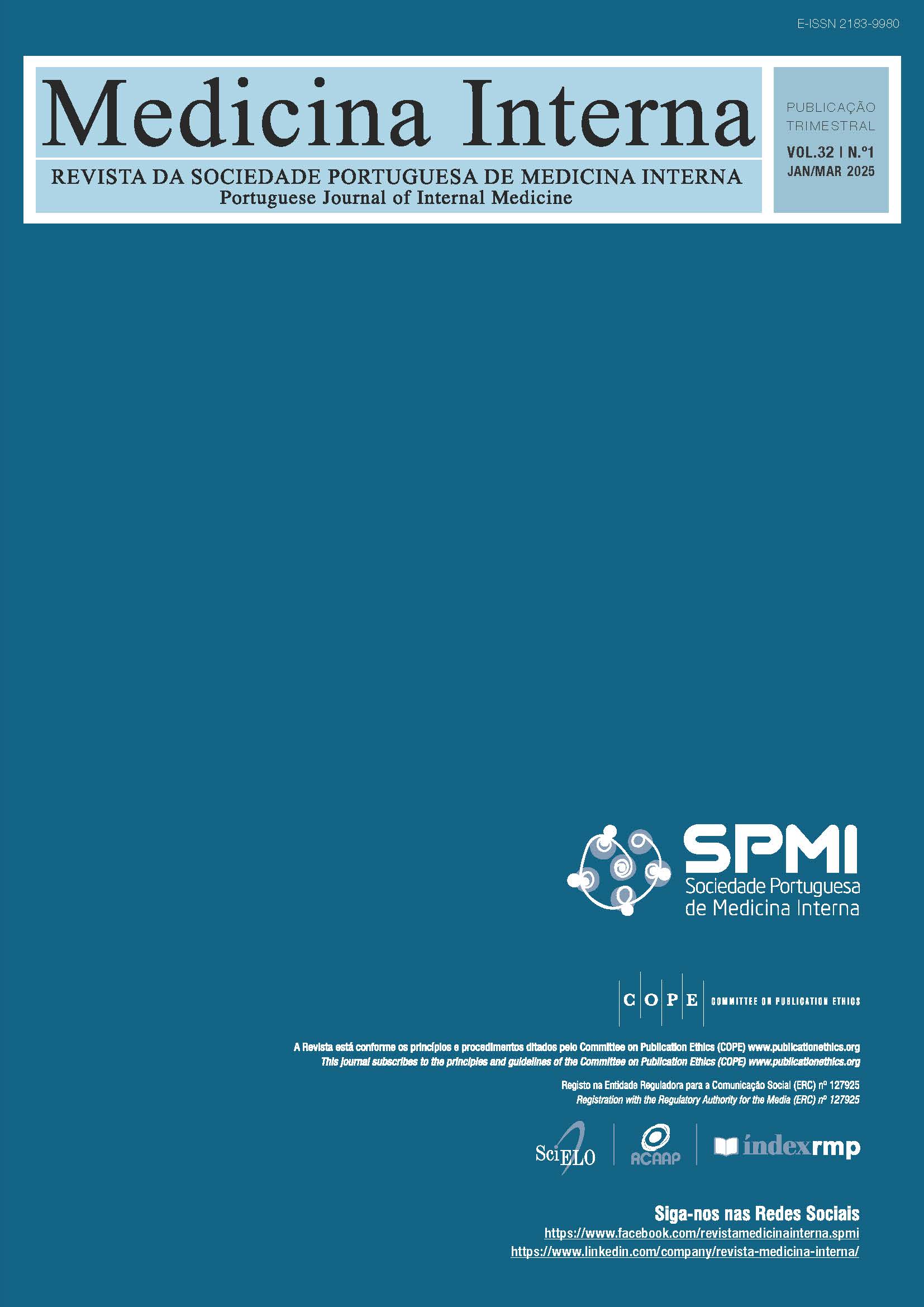Diabetes, a Possible Treatable Trait in Chronic Obstructive Pulmonary Disease: Analysis of a Cohort
DOI:
https://doi.org/10.24950/rspmi.2595Palavras-chave:
Diabetes Mellitus, Pulmonary Disease, Chronic Obstructive/therapyResumo
Introduction: Diabetes mellitus is a common comorbidity and is associated with a worse prognosis in chronic obstructive pulmonary disease. Recently, an approach based on treatable traits has been proposed to manage chronic
obstructive pulmonary disease. Despite the evidence on the physiopathological relationship between diabetes and chronic obstructive pulmonary disease, data on diabetes as a treatable
trait for chronic obstructive pulmonary disease is still scarce.
Methods: A retrospective cohort study was conducted on chronic obstructive pulmonary disease patients evaluated in the Internal Medicine outpatient clinic of a university hospital. Occurrence of diabetes mellitus, glycemic control and chronic obstructive pulmonary disease outcomes were assessed.
Results: Two hundred seventy-nine chronic obstructive pulmonary disease patients were enrolled. Most patients were male (76.3%). The mean age was 71.1 ± 9.5 years. Diabetes prevalence was 30.8%. Most diabetic patients (54.7%) presented glycemic control under target (HbA1c < 7%). Median HbA1c was 6.7% [1.0]. There was no statistically significant difference in chronic obstructive pulmonary disease stage, acute exacerbation risk, length of hospital stays, and mortality between diabetic and non-diabetic patients.
Conclusion: Diabetes prevalence and incidence in
chronic obstructive pulmonary disease patients were higher in comparison to the general population. Good glycemic control was achieved in most diabetic patients. In this population,
diabetes was not associated with worse outcomes in chronic obstructive pulmonary disease. Diabetes should be considered as a treatable trait of chronic obstructive pulmonary disease and glycemic control should be a therapeutical target among these patients. Internal Medicine consultation has an important role in the integrative approach chronic obstructive pulmonary disease patients benefit from.
Downloads
Referências
Katsiki N, Steiropoulos P, Papanas N, Mikhailidis DP. Diabetes Mellitus and Chronic Obstructive Pulmonary Disease: An Overview. Exp Clin Endocrinol Diabetes. 2021;129:699–704. doi: 10.1055/a-1038-3883.
Adeloye D, Song P, Zhu Y, Campbell H, Sheikh A, Rudan I. Global, regional, and national prevalence of, and risk factors for, chronic obstructive pulmonary disease (COPD) in 2019: a systematic review and modelling analysis. Lancet Respir Med. 2022;10:447–58. doi: 10.1016/S2213-2600(21)00511-7.
Global Initiative for Chronic Obstructive Lung Disease. Global Strategy for Diagnosis, management, and prevention of Chronic Obstructive Lung Disease. 2023 ed. [accessed May 2024]. Available at: https://goldcopd.org/2023-gold-report-2/
Belligund P, Attaway A, Lopez R, Damania D, Hatipoglu U, Zein JG. Diabetes associated with higher health care utilization and poor outcomes after COPD-related hospitalizations. Am J Managed Care. 2022;28:E325–32. doi: 10.37765/ajmc.2022.89225.
McDonald VM, Fingleton J, Agusti A, Hiles SA, Clark VL, Holland AE, et al. Treatable traits: A new paradigm for 21st century management of chronic airway diseases: Treatable Traits down under International Workshop report. Eur Respir J. 2019;53. doi: 10.1183/13993003.02058-2018.
Cardoso J, Ferreira AJ, Guimarães M, Oliveira AS, Simão P, Sucena M. Treatable traits in copd – a proposed approach. Int J COPD 2021;16:3167–82. doi: 10.2147/COPD.S330817.
Park SS, Perez Perez JL, Perez Gandara B, Agudelo CW, Rodriguez Ortega R, Ahmed H, et al. Mechanisms Linking COPD to Type 1 and 2 Diabetes Mellitus: Is There a Relationship between Diabetes and COPD? Medicina. 2022;58. doi: 10.3390/medicina58081030.
Hurst JR, Vestbo J, Anzueto A, Locantore N, Müllerova H, Tal-Singer R, et al. Susceptibility to exacerbation in chronic obstructive pulmonary disease. N Engl J Med. 2010;363:1128-38. doi: 10.1056/NEJMoa0909883.
GBD 2019 Chronic Respiratory Diseases Collaborators. Global burden of chronic respiratory diseases and risk factors, 1990-2019: an update from the Global Burden of Disease Study 2019. EClinicalMedicine. 2023;59:101936. doi: 10.1016/j.eclinm.2023.101936.
Elsayed NA, Aleppo G, Aroda VR, Bannuru RR, Brown FM, Bruemmer D, et al. 2. Classification and Diagnosis of Diabetes: Standards of Care in Diabetes—2023. Diabetes Care. 2023;46:S19–40. doi: 10.2337/dc23-S002.
Elsayed NA, Aleppo G, Aroda VR, Bannuru RR, Brown FM, Bruemmer D, et al. 6. Glycemic Targets: Standards of Care in Diabetes—2023. Diabetes Care. 2023;46:S97–110. doi: 10.2337/dc23-S006.
Machado FVC, Pitta F, Hernandes NA, Bertolini GL. Physiopathological relationship between chronic obstructive pulmonary disease and insulin resistance. Endocrine. 2018;61:17–22. doi: 10.1007/s12020-018-1554-z.
Rogliani P, Calzetta L, Segreti A, Barrile A, Cazzola M. Diabetes mellitus among outpatients with COPD attending a university hospital. Acta Diabetol. 2014;51:933–40. doi: 10.1007/s00592-014-0584-0.
Khateeb J, Fuchs E, Khamaisi M. Diabetes and lung disease: An underestimated relationship. Rev Diabetic Stud.2019;15:1–15. doi: 10.1900/RDS.2019.15.1.
Nascimento TS, Amaral TL, Amaral CA, Vasconcellos TM, Monteiro GT. Prevalência de diabetes mellitus e fatores associados em adultos: inquérito de base populacional. https://docs.bvsalud.org/biblioref/2023/09/1510570/11514-publicacao-66486-1-10-20230725.pdf
International Diabetes Federation. Portugal - IDF Europe Site, [accessed May 2024]. Available at: https://idf.org/europe/our-network/our-members/portugal/
Rogliani P, Lucà G, Lauro D. Chronic obstructive pulmonary disease and diabetes. COPD Res Pract. 2015;1. doi: 10.1186/s40749-015-0005-y.
Walter RE, Beiser A, Givelber RJ, O’Connor GT, Gottlieb DJ. Association between glycemic state and lung function: The Framingham Heart Study. Am J Respir Crit Care Med 2003;167:911–6. doi: 10.1164/rccm.2203022.
Cazzola M, Calzetta L, Rogliani P, Lauro D, Novelli L, Page CP, et al. High glucose enhances responsiveness of human airways smooth muscle via he Rho/ROCK pathway. Am J Respir Cell Mol Biol. 2012;47:509–16. doi: 10.1165/rcmb.2011-0449OC.
Mannino DM, Thorn D, Swensen A, Holguin F. Prevalence and outcomes of diabetes, hypertension and cardiovascular disease in COPD. Eur Respir J. 2008;32:962–9. doi: 10.1183/09031936.00012408.
Crisafulli E, Torres A, Huerta A, Mendez R, Guerrero M, Martinez R, et al. C-reactive protein at discharge, diabetes mellitus and ≥1 hospitalization during previous year predict early readmission in patients with acute exacerbation of chronic obstructive pulmonary disease. COPD. 2015;12:311–20. doi: 10.3109/15412555.2014.933954.
Parappil A, Depczynski B, Collett P, Marks GB. Effect of comorbid diabetes on length of stay and risk of death in patients admitted with acute exacerbations of COPD. Respirology. 2010;15:918–22. doi: 10.1111/j.1440--1843.2010.01781.x.
Deshpande AD, Harris-Hayes M, Schootman M. Epidemiology of Diabetes and Diabetes-Related Complications. Phys Ther. 2008;88:1254–64. doi: 10.2522/ptj.20080020.
Choi BH, Ryu DY, Ryoo IG, Kwak MK. NFE2L2/NRF2 silencing-inducible miR-206 targets c-MET/EGFR and suppresses BCRP/ABCG2 in cancer cells.Oncotarget. 2017; 8:107188-107205. doi: 10.18632/oncotarget.2251
Standards of Care in Diabetes-2023 Abridged for Primary Care Providers. Clin Diabetes. 2023;41:4–31. doi: 10.2337/cd23-as01.
Miravitlles M, Auladell-Rispau A, Monteagudo M, Vázquez-Niebla JC, Mohammed J, Nuñez A, et al. Systematic review on long-term adverse effects of inhaled corticosteroids in the treatment of COPD. Eur Respir Rev. 2021;30. doi: 10.1183/16000617.0075-2021.
Downloads
Publicado
Como Citar
Edição
Secção
Categorias
Licença
Direitos de Autor (c) 2025 Medicina Interna

Este trabalho encontra-se publicado com a Licença Internacional Creative Commons Atribuição 4.0.
Direitos de Autor (c) 2023 Medicina Interna
Acesso livre










